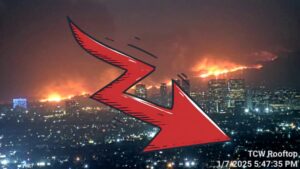Cat bond price mark-down from LA wildfires expands, with new names in focus

The mark-to-market impact to catastrophe bonds from the Los Angeles, California wildfires has risen, as a number of cat bond names saw further mark-downs on pricing sheets last Friday, while some aggregate cat bonds saw negative movements that had not done so before.
It’s important to qualify, the extent of mark-downs of cat bond secondary prices after the wildfires depends on the pricing sheet looked at, as they are far from evenly marked across banks and brokers at this time.
We estimated the write-down across the cat bonds tranches with more meaningful price movements due to the wildfires at around $200 million, after the January 17th marks.
Movements in prices continued the next week, although nothing particularly dramatic aside from a further degradation in two of the occurrence catastrophe bonds that are exposed to potential LA wildfire losses.
At the most recent secondary cat bond pricing on Friday January 31st, negative price moves continued for some annual aggregate cat bond names, but new aggregate cat bond names have also been added to the list of those falling more than 5% at the mid of bid and offer.
Given the expansion of mark-downs to additional names and also the further negative price movements for some already marked-down cat bonds, it’s safe to assume the overall mark-down of the catastrophe bond market now stands above the roughly $200 million of a fortnight ago.
In fact, as reported first by catastrophe bond fund manager Icosa Investments, the cat bond market total return was negative for January 2025, at roughly -1%.
Given the size of the cat bond market, a nearly 1% decline in the Swiss Re Index might imply a mark-down of more than $400 million.
But, it’s important to note that this remains mark-to-market at this time, with no realised catastrophe bond losses from the California wildfires yet, while much of the mark-down is attributed to aggregate deals that may never face a realised loss, rather just suffering from attachment erosion at this stage.
So it seems likely there is a good deal of that 1% to be recovered over the coming months, although with the aggregate cat bonds it will depend on any losses from other perils that they cover.
Drivers of rising and expanding cat bond price mark-downs are perceptions the ultimate insurance and reinsurance industry loss from the wildfires could be higher than anticipated, plus some early loss pronouncements from companies sponsoring cat bonds, as well as loss estimates from other major reinsurance players.
In addition, as the scale of the wildfire losses becomes clearer, the industry is realising that a larger proportion of the loss is expected to flow to reinsurance and retrocessional capital, with evident ramifications for the insurance-linked securities (ILS) market.
At pricing on Friday January 31st, there was an additional negative price movement for the Class A notes of Fidelis’ Herbie Re Ltd. (Series 2021-1) aggregate industry-loss trigger cat bond, which we understand fell another 20% or more at the mid, and are told that on one sheet these are now marked for bids as low as 15 cents on the dollar.
Next, Liberty Mutual’s most recent cat bond, the Mystic Re IV Ltd. (Series 2025-1) issuance, whose $100 million Class C notes had fallen by around 15% at the mid previously due to potential wildfire exposure, but on Friday fell a further 35%, leaving them marked for bids as low as 35, we understand.
Next, across USAA’s Residential Reinsurance 2021 Limited (Series 2021-1) Class 11 and Class 12 notes, as well as its Residential Reinsurance 2022 Limited (Series 2022-1) cat bond’s Class 11 and Class 12 notes, which had all been marked down before, price falls of between 15% and 25% at the mid of bid and offer were seen in the latest pricing sheets, sources said.
However, two more tranches of aggregate ResRe cat bond notes also saw price declines at the latest marking, adding to the mark-downs seen. With the $125 million Class 13 tranche of the Residential Reinsurance 2023 Limited (Series 2023-1) issuance dropping around 28% at the mid, and the $50 million Class 13 tranche of the Residential Reinsurance 2024 Limited (Series 2024-1) issuance dropping around 15%, we understand.
Finally, we’re told that three tranches of outstanding Sanders catastrophe bond notes from sponsoring insurer Allstate also saw more meaningful price declines last week, the first time we’ve added these to the roster of cat bonds considered at-risk from the California wildfires.
Needless to say, the three Sanders Re cat bond tranches that saw price moves this week all provide Allstate with annual aggregate reinsurance protection, so presumably the marking is due to a rising expectation of attachment erosions due to the wildfire losses.
The $150 million Class B tranche of the Sanders Re II Ltd. (Series 2021-2) issuance, that provide both aggregate and occurrence protection fell by 55% at the mid of bid and offer, we are told.
The $175 million Class C notes from the Sanders Re III Ltd. (Series 2022-1) issuance, solely an aggregate reinsurance cover, fell over 50% as well.
While the $150 million Class B notes from the Sanders Re III Ltd. (Series 2023-1) issuance, again an aggregate cover only, fell by roughly 10%, we understand.
With additional catastrophe bonds seeing their prices marked down this week, it is clear the cat bond market exposure increased at the end of January 2025 pricing.
Which was reflected in the Swiss Re Index, that fell by roughly 1% for January, the first negative January return in the long history of this catastrophe bond market benchmark.
As we said though, at least some of these negative movements are likely to be recovered.
While, for the aggregate notes that are exposed to attachment erosion from the fires, unless further catastrophe events erode these buffers to the point of attaching the coverage, causing reinsurance recoveries and losses of principal, these would recover their values in full at the end of their risk periods.
Read all of our coverage related to the Los Angeles, California wildfires here.






